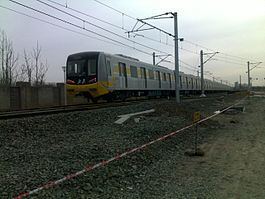Type Rapid transit Status Completed Character Underground | System Beijing Subway Opened 30 December 2012 Stations 27 | |
 | ||
Daily ridership 601,900 (2014 Avg.)
958,000 (2016 Peak) Operator Beijing Mass Transit Railway Operation Corporation Limited Terminis Lucheng Station, Haidian Wuluju Station | ||
Line 6 of the Beijing Subway (Chinese: 北京地铁6号线; pinyin: běijīng dìtiě liùhào xiàn) is a rapid transit rail line in central Beijing. The line currently runs parallel to the north of Line 1 and the Batong Line, from Wulu in Haidian to Lucheng in Chaoyang District. It serves important residential areas such as Changying, Chaoqing, and Dingfuzhuang, in addition to important commercial and business areas such as Financial Street and Beijing CBD. It is planned that the line will be extended by 2015 to Shijingshan to the west. With this extension, it is expected to be 50.67 km long with 32 stations.
Contents
- Planning
- Route and Stations
- Phase I
- Phase II eastern extension
- Phase III western extension
- Stations
- History
- References
Line 6 uses Beijing Subway's highest capacity rolling stock to date featuring 8-car size B train sets accommodating 1,960 people, compared to the standard 6 cars found on other lines except the Airport Express line which has 4-car train sets. It is also the fastest in the subway system, with trains capable of reaching the speed of 100 km/h compared to 80 km/h on other lines. Stations to the east of the 3rd Ring Road to Tongzhou are more widely spaced, the furthest being 4 km apart. These factors allows passengers to travel the whole line in just 48 minutes. Line 6 also has the deepest station in the network, Dongsi Station, which is 34 meters underground. The line uses 1500 V overhead catenary as opposed to 750 V third rail used on other lines. Some of the station arrangements where the first of its kind in Beijing. Beijing's first split platform station and stations equipped with passing tracks, opened on Line 6.
Planning
Line 6 was originally planned to be an east–west line passing under Chaoyang Avenue continuing straight westward. However this alignment will make the central section of Line 6 tunnel extremely close to the Forbidden City. Issues of historic conservation and protection were raised against the proposed alignment. To avoid damaging cultural relics in the area, the entire western and middle section of line 6 was shifted 1.5 km northward to Ping'an Avenue, forming the route of Line 6 today. Line 6 started construction on December 8, 2007 as one of the "horizontal" east–west lines of the "three-ring, four horizontal and five vertical and seven radial" Beijing Subway masterplan.
Line 6 was originally planned to terminate at Cishousi Station with the Mentougou Low Speed Maglev Line continuing the line westward. However issues of low of capacity and electromagnetic radiation concerns of Maglev technology, the Mentougou Maglev section between Cishousi and Pingguoyuan station was replaced by a new Phase 3 western extension of Line 6. Later the plan was revised with Line 6 being further extended westward beyond Pingguoyuan to Jin'anqiao station, paralleling the Mentougou Maglev Line.
Route and Stations
Construction is planned in three phases, the first phase in central Beijing, followed by extensions into the eastern and western suburbs. Line 6 is projected to have a short term volume of 700,000 passengers per day and a long term daily passenger traffic of 1.4 million passengers. Though due to its alignment through some of Beijing's densest residential neighborhoods and paralleling the overcapacity and busy Line 1, some industry leaders believe that the average daily passenger flow of the line may reach 1.4 million passengers per day sooner than expected. Within the first few months of operation weekday ridership was at 320,000 passengers. However, by 2014, daily ridership has risen to 700,000 with sections operating at 100% capacity during rush hour. Authorities responded by adding more trains and shortening headway to reduce crowding.
Phase I
In Phase I, Line 6 runs 30 km from Wulu in Haidian District to Caoying in Tongzhou District following Linglong Road, Sanlihe Road, Chaoyang North Rd., the west bank of the Grand Canal, and Grand Canal East Road. Of the 20 planned stations, 12 will offer transfer connections to other lines. Construction began in December 2007 and was completed in 2012. Total investment for Phase I was estimated at ¥19.7 billion.
Line 6 in Phase I was originally slated to have elevated tracks for 7 km, east of the 5th Ring Road, from Dingfuzhuang and Changying. After residents along the route raised concerns about train noise, planners reconsidered and ultimately decided to keep all of Phase I under ground. This made the first phase of Line 6 completely underground.
Phase II (eastern extension)
In Phase II, Line 6 was extended further east by about 12 km through 7 stations from Caofang to Lucheng in the Tongzhou New City. It is planned to have express and local services using passing tracks at select stations.
Like Phase I, Phase II track is entirely underground.
Phase III (western extension)
In 2011, city planning authorities proposed to detach from the planned Line S1 of the Beijing Suburban Railway (Mentougou Line) and add to Line 6 as a western extension, an 8.9-km section with five stations from Pingguoyuan to Tiancun. The revision, made in response to public concerns about electromagnetic radiation from maglev trains on Line S1 and to expand Pingguoyuan into mass transit hub, was formalized and submitted to the National Development and Reform Commission for review in March 2012.
The planned stations, from west to east, are:
Three of the five stations will be below ground and the other two stations will be elevated above ground.
Stations
Stations from west to east (and transfer stations with other lines):
